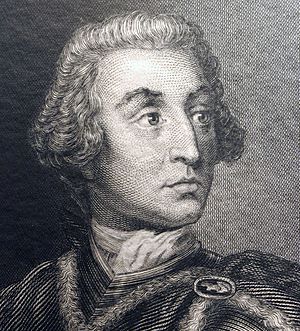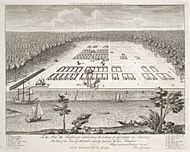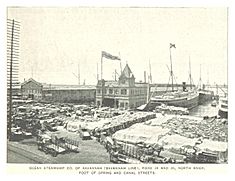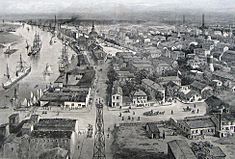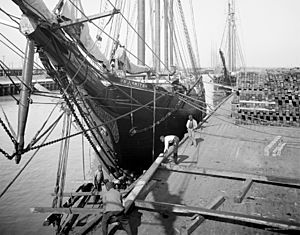History of Savannah, Georgia facts for kids
The city of Savannah, Georgia is the biggest city in Chatham County, Georgia. It was started in 1733 and was the first capital of Georgia. Savannah is known as Georgia's first planned city. Millions of people visit Savannah to see its beautiful architecture and old buildings. Some famous places include the birthplace of Juliette Gordon Low, who started the Girl Scouts of the United States of America. Other important spots are the Telfair Academy of Arts and Sciences (one of the South's first public museums), the First African Baptist Church (one of the oldest Black Baptist churches in the U.S.), Congregation Mickve Israel (the third-oldest synagogue in America), and the Central of Georgia Railway roundhouse complex (the oldest standing old rail building in America). Today, downtown Savannah is one of the largest National Historic Landmark Districts in the United States.
History of Savannah
Early Settlers
The Yamacraws, a Native American tribe, were the first known people to live in and around Savannah. In the 1700s, their leader Tomochichi met the new European settlers arriving in the area.
British Arrival
In November 1732, a ship called Anne sailed from Britain with 114 colonists, including General James Oglethorpe. On February 12, 1733, Oglethorpe and his group landed at Yamacraw Bluff. They were welcomed by Tomochichi, the Yamacraws, and John and Mary Musgrove, who were Indian traders. Mary Musgrove often helped by translating. The city of Savannah was founded on that day, along with the Province of Georgia. Because Oglethorpe and Tomochichi were friends, Savannah grew peacefully, unlike many other early American colonies that faced wars. In July 1733, 40 Sephardi Jews from Spain and Portugal arrived in Savannah. This was the largest group of Jewish settlers to enter a colony at that time.
Colony Growth
Before coming to America, Oglethorpe made a detailed plan for how towns and regions would grow. This plan, now called the Oglethorpe Plan, helped create a strong farming economy and deal with challenges from the wild frontier. Parts of this plan, especially for town design, can still be seen in Savannah, as well as in Darien, Georgia and at Fort Frederica National Monument.
After Georgia became a royal colony in 1754, many different Protestant groups settled there. These churches were very important to the American Revolutionary movement. Their ministers gave speeches that encouraged people to fight for freedom from Britain.
Over the next 150 years, Savannah welcomed many other immigrants. These included Irish Catholics, French Catholics and Huguenots, Greek Orthodox, and others.
In 1740, George Whitefield started the Bethesda Orphanage. It is now the oldest orphanage still operating in the United States.
Solomon's Lodge was founded in 1733 or 1734 by James Oglethorpe. It is thought to be the oldest continuously running English Masonic Lodge in the Western Hemisphere. It was first called the Lodge of Savannah and was officially renamed Solomon's Lodge in 1776.
Savannah as a British Colony
Savannah and the rest of Georgia became a Royal Colony in 1754. More settlers and workers came to the growing colony. Savannah became the capital of the colony. The low marshlands were turned into rice fields. These fields were worked by skilled laborers. The combination of English farming methods and African labor helped the city greatly.
Over time, Creek groups gradually gave up lands to European settlers. In 1763, the Creeks agreed to give Georgia land between the Savannah and Ogeechee rivers. More land was given to Georgia by the Creeks and Cherokees in 1773.
Savannah's economy also grew after the Treaty of Paris in 1763. This treaty opened up the inside of North America to British trade. This was a big step for Savannah, as it started strong trade connections with the inland areas. Trade, especially the trade of deerskins, became very popular along the upper Savannah River. The deerskins were sent to Augusta and then through Savannah to be shipped to Europe. This trading network helped Savannah become an important port on the South Atlantic coast. Between 1764 and 1773, Savannah exported hides from 500,000 deer. This made the city a major commercial port.
American Revolution Era
In 1778, during the American Revolutionary War, Savannah was taken over by British and Loyalist forces. In 1779, American and French troops tried to take the city back during the Siege of Savannah, but they were not successful.
Late 1700s and Early 1800s
On January 27, 1785, members of the State Assembly met in Savannah to create the nation's first public university, the University of Georgia (in Athens). In 1792, the Savannah Golf Club opened near Fort Jackson. It is the first known American golf club.
American Civil War Impact
I beg to present you as a Christmas gift the City of Savannah, with one hundred and fifty guns and plenty of ammunition, also about twenty-five thousand bales of cotton.
In November 1864, after capturing Atlanta, General William Tecumseh Sherman and his army of 62,000 men began their march south to Savannah. They lived off the land and caused a lot of damage. Sherman called this tough way of fighting "hard war."
Sherman and his troops captured Savannah on December 22, 1864. Sherman then sent a message to President Abraham Lincoln, offering him the city as a Christmas gift.
19th Century Growth
As the 1800s went on, Savannah's population grew a little, but its wealth grew a lot. However, its rank among the largest U.S. cities steadily dropped. Savannah State University was founded in 1890 and is the oldest public college for African Americans in Georgia.
Savannah's Original Design
Savannah's physical layout was carefully planned by the people who founded the Georgia colony. Oglethorpe's Savannah Plan had six connected areas, each built around a central square. Public buildings and churches were on the east and west sides of the squares. Private homes were on the north and south sides. The city continued to follow Oglethorpe's general plan until the 1850s.
The organized, Neo-classical design of downtown Savannah was connected to the outside by three main roads. These roads linked Savannah to other important places and plantations.
Economic Development
Cotton Industry
The Savannah Cotton Exchange was started in 1876. It moved to its permanent home on Bay Street in 1883. Warehouses were located below on River Street. The exchange helped cotton brokers meet and set the price of cotton shipped to bigger markets like New York or London. By the late 1800s, more farmers were selling their cotton inland and just shipping it from Savannah using the many rail connections.
By 1870, three main railroads connected Savannah to markets along the coast and inland. The Central of Georgia Railway, the Savannah and Charleston, and the Savannah and Gulf railroads helped the city grow. The Central of Georgia built its own docks and canals west of the existing riverfront. This was the first time industrial activity moved outside the city's main plan. Another railroad was built to Tybee Island in 1887. This allowed city residents to easily visit the beach.
The 1800s saw cotton become a very important crop, changing Savannah's economy. The invention of the cotton gin in 1793 by Eli Whitney greatly changed farming in the American South. Whitney developed the gin at Mulberry Grove Plantation near Savannah.
The cotton gin made it possible to grow cotton widely in the inland areas. This had a huge impact on Savannah. Farmers along the upper Savannah River shipped their cotton downriver to Savannah for market and export. This increase in trade led to a rise in population. By 1820, Savannah was the eighteenth-largest urban area in the United States. In 1818, shipping and business stopped for a short time when the city was put under quarantine because of a yellow fever epidemic.
In 1828, work began on the Savannah-Ogeechee Canal. This canal connected the Ogeechee River to the Savannah River. The canal was finished in 1831, bringing resources from Georgia's interior to Savannah. The city's growth in the 1830s and 1840s led to a new city map, published in 1853.
Even with its smaller population, Savannah became very wealthy. By 1820, Savannah was exporting goods worth $18 million. This wealth came from the development of new lands and the labor of many people.
Industry and Manufacturing
Savannah's economy became more diverse as heavy industry and manufacturing came to the region in the late 1800s and early 1900s. Union Camp, a paper company, set up its mill upriver from the city's historic center. The Kehoe Iron Works was also started in 1883.
As working-class residents moved to neighborhoods near these new industries, the population in the crowded historic downtown began to spread out. The city's population grew by 65 percent between 1900 and 1920.
Another boost to Savannah's economy came from the increased export of naval stores. These were items like pitch and turpentine, which came from South Atlantic yellow pine trees. These were important for building and maintaining wooden ships. In 1902, Charles Herty changed the naval stores industry. He found a new way to collect the raw sap from yellow pine trees that was more effective and allowed the trees to keep growing. This also helped Savannah become a major lumber exporter. With huge yellow pine forests, Savannah became the world's main exporter of naval stores.
The boll weevil outbreak in the 1920s badly hurt the cotton market in Savannah and the South. The naval stores industry also declined by World War II as iron replaced wood in ship building. Savannah's economy continued to change as more heavy industry was added upriver. During World War II, Savannah's factories helped the war effort by building Liberty ships.
Tourism Growth
In the 1930s and 1940s, some of Savannah's old buildings were torn down. This trend seemed to speed up in the 1950s. People became worried about losing the city's history. In 1955, the demolition of the City Market and an attempt to tear down the Davenport House led seven women to create the Historic Savannah Foundation. In the late 1950s and through the 1960s, this foundation helped stop more historic buildings from being destroyed and worked to save original structures. In 1978, the Savannah College of Art and Design was founded. Instead of building one big campus, it started renovating and reusing many important downtown buildings. These efforts, along with the work of the Historic Savannah Foundation, have greatly helped Savannah become famous again.
The city became more popular for tourists in the 1980s. Its fame grew even more with the best-selling 1994 book and 1997 movie Midnight in the Garden of Good and Evil, both set in Savannah.
Savannah has also become a popular place to celebrate St. Patrick's Day, with one of the largest parades in the United States.
Images for kids


